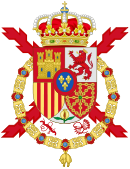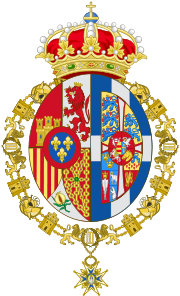- Queen Sofía of Spain
-
Sofía of Greece and Denmark 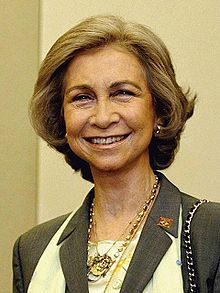
Queen consort of Spain (more) Tenure 22 November 1975 – present Spouse Juan Carlos I of Spain Issue Infanta Elena, Duchess of Lugo
Infanta Cristina, Duchess of Palma de Mallorca
Felipe, Prince of AsturiasFull name English: Sophia Margaret Victoria Frederica
Spanish: Sofía Margarita Victoria Federica
Greek: Σοφία Μαργαρίτα Βικτωρία ΦρειδερίκηHouse House of Bourbon
House of Schleswig-Holstein-Sonderburg-GlücksburgFather Paul of Greece Mother Frederika of Hanover Born 2 November 1938
Psychiko, Athens, GreeceSignature 
Religion Roman Catholic
prev. Greek OrthodoxQueen Sofía of Spain (Spanish pronunciation: [soˈfi.a], née: Princess Sophia Margaret Victoria Frederica of Greece and Denmark; Spanish: Sofía de Grecia y Dinamarca; Greek: Βασίλισσα Σοφία της Ισπανίας, Vasílissa Sofía tis Ispanías; born 2 November 1938) is the wife of King Juan Carlos I of Spain.[1][2]
Contents
Early life and family
Princess Sophia of Greece and Denmark was born in Psychiko, Athens, Greece on 2 November 1938, the eldest child of the King Paul of Greece (1901–1964) and his wife, Queen Frederika (1917–1981), a former princess of Hanover. Queen Sofia is a member of the Schleswig-Holstein-Sonderburg-Glücksburg dynasty. Her brother is the deposed King Constantine II of Greece and her sister Princess Irene of Greece and Denmark. However, since the abolition of the monarchy, the royal titles are recognized by the Dutch Monarchy and the Danish Royal Family.
Princess Sophia spent some of her childhood in Egypt where she took her early education in El Nasr Girls' College (EGC) in Alexandria, then went to South Africa during her family's exile from Greece during World War II. They returned to Greece in 1946. She finished her education at the prestigious Schloss Salem boarding school in Southern Germany, and then studied childcare, music and archeology in Athens. Sofia also studied at Fitzwilliam College, Cambridge a constituent college of the University of Cambridge.
Marriage and family
On 14 May 1962 Princess Sophia of Greece and Denmark married Infante Juan Carlos of Spain, whom she met on a cruise of the Greek Islands in 1954, in Athens at the Catholic Cathedral of Saint Dennis. In doing so, she relinquished her rights to the throne of Greece and converted to Roman Catholicism from Greek Orthodoxy, an act of convenience in order to become more palatable to Catholic Spain. Further, the Latin transliteration of her Greek name (Σοφία), was changed from Sophia to the Spanish variant Sofía, which nonetheless is pronounced identically to the original Greek version.
In 1969, Prince Juan Carlos, who was never Prince of Asturias, the traditional title of the heir to the throne, was given the official title of Prince of Spain by the Spanish state; this was a title suggested by Sofia herself. Juan Carlos acceded to the throne as Juan Carlos I in 1975.
The couple have three children: HRH Infanta Elena, Duchess of Lugo born 20 December 1963, HRH Infanta Cristina, Duchess of Palma de Mallorca born 13 June 1965, and HRH Felipe, Prince of Asturias born 30 January 1968. The King and Queen have eight grandchildren, four boys and four girls: Felipe and Victoria from the Infanta Elena; Juan, Pablo, Miguel and Irene from the Infanta Cristina; and Infanta Leonor, and Infanta Sofía, named in her honor, of Prince Felipe; all of whom are in the line of succession to the Spanish Throne.
Ancestry
Queen Sofía is both a great-great-granddaughter (paternally) and a great-great-great-granddaughter (maternally) of Queen Victoria of the United Kingdom and is, through several lines, her husband's third cousin. She is a first cousin of Ernst August of Hanover, and through her great-grandfather George I of Greece, she is a second cousin to Charles, Prince of Wales. Through Christian IX of Denmark and Queen Victoria, she is also related to Elizabeth II and thereby related to all the royal families of Europe. She is also a first cousin once removed of Elizabeth II's husband, Prince Philip, Duke of Edinburgh. Queen Sofia is of Hohenzollern descent through her mother, Frederica of Hanover, and through her paternal grandmother, Sophia of Prussia, and of Romanov descent through her father's paternal grandmother, Olga Constantinovna of Russia.
Royal duties
Spanish Royal Family HM The King
HM The Queen- HRH The Prince of Asturias
HRH The Princess of Asturias - HRH The Duchess of Lugo
- HRH The Duchess of Palma de Mallorca
HE The Duke of Palma de Mallorca
Extended royal familyBesides travelling with her husband within Spain and abroad, the Queen has her own agenda. She is the executive president of the Queen Sofía Foundation, which in 1993 sent funds for relief in Bosnia and Herzegovina, and is the honorary president of the Royal Board on Education and Care of Handicapped Persons and the Foundation for Aid for Drug Addicts. She takes special interest in programs against drug addiction, travelling to conferences in both Spain and abroad. The Museo Nacional Centro de Arte Reina Sofía is named after her, as is Reina Sofía Airport in Tenerife. Queen Sofia is often seen representing the Spanish Royal Family at weddings of other European royal families, most recently at the wedding of Victoria, Crown Princess of Sweden, and Daniel Westling in 2010 and the wedding of Prince William and Catherine Middleton in 2011, since her husband the King has expressed his wish not to attend weddings and other such royal functions. As a keen supporter of sports of all kind, the Queen also attended the final match of the 2010 Wimbledon Championships - Men's Singles where she watched Spanish tennis champion Rafael Nadal win for a second time, as well as the 2010 FIFA World Cup where the team from Spain was crowned as world champion.
She has been working closely with Dr. Muhammed Yunus on his Grameen Bank (or "Village Bank"), which offers microcredits to women across the world. Sofía has travelled to Bangladesh, Chile, Colombia, El Salvador and Mexico to support the activities of the organization led by Yunus.
Queen Sofia of Spain has also been a strong supporter of Somaly Mam's efforts and that of the NGO she founded, AFESIP (Agir pour les Femmes en Situation Précaire), in combating child prostitution and slavery in Cambodia. In 1998, Somaly Mam was awarded the prestigious Prince of Asturias Awards for International Cooperation in the presence of Queen Sofia.
The Queen is an Honorary Member of the San Fernando Royal Academy of Fine Arts and of the Royal Academy of History. She has received Honorary Doctorates from the Universities of Rosario (Bogotá), Valladolid, Cambridge, Oxford, Georgetown, Evora, St. Mary's University, Texas, and New York.
Life and lifestyle
In addition to Greek and Spanish, she also speaks French, English, Italian, and German. Her Majesty is also considered as one of the most fashionable royals in Europe and there's always great interest in her clothing at royal gatherings.
Opinions
Greek Royal Family 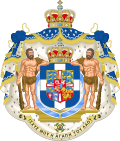
- HRH The Crown Prince
HRH The Crown Princess- HRH Princess Maria-Olympia
- HRH Prince Constantine-Alexios
- HRH Prince Achileas-Andreas
- HRH Prince Odysseas-Kimon
- HRH Prince Aristidis-Stavros
- HRH Princess Alexia
- HRH Prince Nikolaos
HRH Princess Tatiana - HRH Princess Theodora
- HRH Prince Philippos
Extended royal familyAn interview for the occasion of the Queen's 70th birthday with Opus Dei journalist Pilar Urbano revealed some details of the Queen's conservative ideals on politically debated issues and the lifestyle of the Queen. Strong controversy arose from comments against the same-sex marriage law recently approved by the Spanish Parliament, and also against Gay Pride demonstrations. "I can understand, accept and respect that there are people of other sexual tendencies, but why should they be proud to be gay?” she asked. "Should they ride on a parade float and come out in protests? If all of us who are not gay were to parade in the streets, we’d halt the traffic in every city.” On the subject of gay marriage, legal since 2005 in Spain, she offered these thoughts: "If those people want to live together, dress up like bride and groom and marry, they could have a right to do so, or not, depending on the law of their country, but they should not call this matrimony, because it isn't”. These opinions forced the Spanish Monarchy to be the center of the claim for a new Spanish Republic during 2009 Gay Pride Parade in Madrid, in which participation of left party Izquierda Unida included showing more than 100 republican flags.
She also critizised the military intervention in Afghanistan, where Spanish troops were taking part at the moment, her defence of religious education in schools, and her conviction that gender violence publicity will encourage new cases to happen.[3] Her opinions were the object of lively criticism from LGTB associations and from Spanish intellectuals.[4] Also responding were Spanish republican political parties like IU and ERC. Government party decided to keep silence, while conservative party PP decided to do so, after a first criticism of the Queen's political intervention from its representative.[5]
Also controversial were her publicly exposing private conversations between King Juan Carlos of Spain and King Hassan II of Morocco, and her revealing King Juan Carlos's autocratic references to Spanish regions as "my lands" (mis tierras).
She mentioned her relationship with her daughter-in-law Letizia Ortiz, a former divorcée, saying that Letizia has brought her closer to the people, and that she and Letizia spend time together and visit restaurants and shops. On the election of Barack Obama, she said how surprised she was that for the first time in the USA a black candidate might be elected as president, and said she does not tolerate racism. She also mentioned that the King would never abdicate, and that she is against abortion and euthanasia. After the uproar, a press release was issued mentioning that the Queen considered her words were expressed in private conversations and were 'inaccurate'. Pilar Urbano defended herself saying that the book had been sent to the Palace for approval and that everything in the book is documented.
Some members of the Spanish royal family, including the King's sister, the Infanta Pilar, Duchess of Badajoz (who declared her total agreement with Sofia), supported the Queen's opinions.
Royal styles of
Sofía, Queen of Spain
Reference style Her Majesty Spoken style Your Majesty Alternative style Ma'am Titles, honours and arms
Titles
Here is a list of titles Queen Sofía held from birth in chronological order :
- Her Royal Highness Princess Sophia of Greece and Denmark (1938–1962)
- Her Royal Highness Princess Sofía of Spain (1962–1969)
- Her Royal Highness The Princess of Spain (1969–1975)
- Her Majesty The Queen of Spain (1975–present)
Spanish honours
- Dame Grand Collar of The Royal and Distinguished Order of Charles III.
- Dame of the Royal Order of Queen Maria Luisa (1,193rd lady on 14 May 1962).
Foreign honours
 Collar of the Order of the Aztec Eagle
Collar of the Order of the Aztec Eagle Dame Grand Cross of the Order of the Royal House of Chakri
Dame Grand Cross of the Order of the Royal House of Chakri Grand Cross of the Order of the Netherlands Lion
Grand Cross of the Order of the Netherlands Lion Knight of the Order of the Elephant
Knight of the Order of the Elephant Grand Cross of the Order of St. Olav
Grand Cross of the Order of St. Olav Member of the Order of the Seraphim
Member of the Order of the Seraphim Grand Cross of the Order of Leopold
Grand Cross of the Order of Leopold Grand Cross of the Order of the Southern Cross
Grand Cross of the Order of the Southern Cross Grand Cross of the National Order of the Légion d'honneur
Grand Cross of the National Order of the Légion d'honneur Grand Cross Special Class of the Order of Merit of the Federal Republic of Germany
Grand Cross Special Class of the Order of Merit of the Federal Republic of Germany Grand Cross of the Order of St. Olga and St. Sophia
Grand Cross of the Order of St. Olga and St. Sophia Grand Cross of the Order of the Falcon
Grand Cross of the Order of the Falcon Collar Lady of the Equestrian Order of the Holy Sepulchre in Jerusalem
Collar Lady of the Equestrian Order of the Holy Sepulchre in Jerusalem Order of the White Double Cross
Order of the White Double Cross Dame Grand Cordon of the Order of Chula Chom Klao
Dame Grand Cordon of the Order of Chula Chom Klao Dame Grand Cross of the Order of the Queen of Sheba
Dame Grand Cross of the Order of the Queen of Sheba Dame Grand Cross of the Order of Ojaswi Rajanya
Dame Grand Cross of the Order of Ojaswi Rajanya Grand Cross of the Order of the Redeemer
Grand Cross of the Order of the Redeemer First Class of the Order of the Precious Crown
First Class of the Order of the Precious Crown Dame Grand Cross decorated with Grand Cordon of the Order of St. James of the Sword
Dame Grand Cross decorated with Grand Cordon of the Order of St. James of the Sword Special Class of the Order of the Mohammediya
Special Class of the Order of the Mohammediya Lady of the Order of the Golden Lion of Nassau
Lady of the Order of the Golden Lion of Nassau Dame Grand Cross of Justice of the Sacred Military Constantinian Order of Saint George
Dame Grand Cross of Justice of the Sacred Military Constantinian Order of Saint George Grand Cross with Grand Cordon of the Order of Merit of the Italian Republic
Grand Cross with Grand Cordon of the Order of Merit of the Italian Republic Order of the White Eagle (Poland, 2001)
Order of the White Eagle (Poland, 2001) Grand Cross of the Order of the Star of Romania (2009)
Grand Cross of the Order of the Star of Romania (2009)
Arms
The personal coat of arms of the Queen impales the Spanish Royal Arms (her husband's shield) to the dexter (viewer's left) with her father’s shield, the arms of King Paul of Greece – Azure a cross argent; inescutcheon, the coat of arms of Denmark as used when George I became king of Greece and showing the dynastic link to the Schleswig-Holstein-Sonderburg-Glücksburg dynasty; a shield containing a cross argent fimbriated gules from the Danish flag and subcoats representing Denmark, Schleswig, the former Kalmar Union, Iceland, the Faroe Islands, Greenland, Holstein, Stormarn, Dithmarschen, Lauenburg, Oldenburg, Delmenhorst, and the former Danish royal titles of King of the Wends and Goths.
All surmounted by the Spanish Royal Crown (Crown's arches differenced as consort) and surrounded by the Collar of the Order of Charles III.[6][7]
The Queen's coat of arms has no official status. In Spain only the coats of arms of the King and the Prince of Asturias are official.
References
- ^ Royal house of Bourbon, Unknown publisher, unknown date (accessed 19 January 2007)
- ^ Her majesty the Queen www.sispain.org unknown date (accessed 19 January 2007)
- ^ "No nos queman a nosotros. Son trozos de papel. Ya se apagarán". Confesiones polémicas de la reina Sofía en un libro al cumplir 70 años en www. elpais.com
- ^ Malestar en el colectivo homosexual por las palabras de la Reina en www.elpais.com
- ^ PP y PSOE ordenan guardar silencio sobre las declaraciones de la Reina en www.elpais.com
- ^ (Spanish) The Arms of the Queen of Spain. Blog de Heráldica - 2 November 2008. (accessed 29 June 2009)
- ^ (Spanish) The Arms of the Queen of Spain (Collar changed). Blog de Heráldica - 2 November 2008. (accessed 29 June 2009)
External links
- Official website of the Spanish Royal Family
- Official website of the Queen Sofia Foundation
- Royal House of Greece
- Royal House of Spain
- Queen Sofia Family Tree
Queen Sofía of SpainBorn: 2 November 1938Spanish royalty Vacant Title last held byVictoria Eugenia of BattenbergQueen consort of Spain
22 November 1975 – presentIncumbent Spanish royal consorts Princess Sophía of Greece and Denmark (1975–)
Princess Victoria Eugenie of Battenberg (1906–1931) · Archduchess Maria Christina of Austria (1879–1885) · Princess Mercedes of Orléans (1878) · Maria Vittoria dal Pozzo (1870–1873) · Infante Francis of Spain, Duke of Cádiz (1846–1868) · Princess Maria Christina of the Two Sicilies (1829–1833) · Princess Maria Josepha of Saxony (1819–1829) · Infanta Maria Isabel of Portugal (1816–1818) · Julie Clary (1808–1813) · Princess Maria Luisa of Parma (1788–1808) · Princess Maria Amalia of Saxony (1759–1760) · Infanta Barbara of Portugal (1746–1758) · Elisabeth Farnese (1724–1746) · Louise Élisabeth d'Orléans (1724) · Elisabeth Farnese (1714–1724) · Princess Maria Luisa of Savoy (1701–1714) · Countess Palatine Mariana of Neuburg (1690–1700) · Marie Louise d'Orléans (1679–1689) · Archduchess Mariana of Austria (1649–1665) · Princess Élisabeth of France (1621–1644) · Archduchess Margaret of Austria (1598–1611) · Archduchess Anna of Austria (1570–1580) · Princess Élisabeth of France (1559–1568) · Queen Mary I of England (1556–1558) · Infanta Isabella of Portugal (1526–1539)First generation 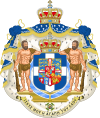
Second generation Helen, Queen of Romania · Olga, Princess Paul of Yugoslavia · Irene, Queen of Croatia and Duchess of Aosta · Elizabeth, Countess of Toerring-Jettenbach · Margarita, Princess of Hohenlohe-Langenburg · Theodora, Margravine of Baden · Marina, Duchess of Kent · Eugénie, Duchess of Castel Duino · Cecilie, Hereditary Grand Duchess of Hesse · Princess Katherine · Sophie, Princess George William of HanoverThird generation Alexandra, Queen of Yugoslavia · Sofía, Queen of Spain · Princess Irene · Princess Alexandra, Mrs. Nicolas Mirzayantz · Olga, Duchess of ApuliaFourth generation Fifth generation 1st generation 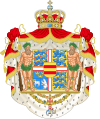
2nd generation Louise, Princess Frederick of Schaumburg-Lippe · Ingeborg, Duchess of Västergötland · Princess Thyra · Princess Dagmar, Mrs. Jørgen Castenskiold · Alexandra, Grand Duchess Paul Alexandrovich of Russia* · Maria Grand Duchess George Mikhailovich of Russia* · Princess Olga* · Margaret, Princess René of Parma3rd generation Feodora, Princess Christian of Schaumburg-Lippe · Caroline-Mathilde, Princess Knud of Denmark · Alexandrine-Louise, Countess Luitpold of Castell-Castell · Helen, Queen of Romania* · Irene, Queen of Croatia and Duchess of Aosta* · Lady Katherine Brandram* · Eugénie, Duchess of Castel Duino* · Olga, Princess Paul of Yugoslavia* · Elizabeth, Countess of Toerring-Jettenbach* · Marina, Duchess of Kent* · Margarita, Princess of Hohenlohe-Langenburg* · Theodora, Margravine of Baden* · Cecilie, Hereditary Grand Duchess of Hesse and by Rhine* · Sophie, Princess George William of Hanover*4th generation Margrethe II · Benedikte, Princess of Sayn-Wittgenstein-Berleburg · Anne-Marie, Queen of the Hellenes · Princess Elisabeth · Alexandra, Queen of Yugoslavia* · Sofía, Queen of Spain* · Princess Irene*5th generation 6th generation * also a princess of GreeceInfantas of Spain by marriage 1st generation 2nd generation none3rd generation 4th generation none5th generation none6th generation none7th generation Louise Élisabeth d'Orléans · Infanta Barbara of Portugal · Princess Maria Amalia of Saxony · Princess Louise Élisabeth of France8th generation Princess Maria Luisa of Parma · Infanta Mariana Victoria of Portugal · Infanta Maria Amalia of Spain* · Archduchess Maria Amalia of Austria9th generation Princess Maria Antonia of Naples and Sicily · Infanta Maria Francisca of Portugal · Infanta Teresa of Portugal, Princess of Beira · Princess Luisa Carlotta of Naples and Sicily10th generation Princess Maria Carolina of the Two Sicilies · Archduchess Maria Beatrix of Austria-Este · Isabella II of Spain* · Infanta Maria Cristina of Spain* · Princess Maria Amalia of the Two Sicilies · Princess Maria Teresa of Savoy11th generation Infanta Eulalia of Spain* · Princess Margherita of Parma · Princess Louise Marie Thérèse of France · Berthe de Rohan · Infanta Maria das Neves of Portugal12th generation Princess Louise of Orléans · Princess Beatrice of Saxe-Coburg and Gotha · Princess Maria Pia of Bourbon-Two Sicilies · Infanta Maria Antonia of Portugal13th generation Princess Mercedes of the Two Sicilies · Princess Alicia of Parma14th generation Princess Sofía of Greece and Denmark · Princess Anne of Orléans15th generation *also an Infanta in her own right
**did not have a royal or noble title by birth but was admitted as InfantaCategories:- 1938 births
- Living people
- People from Psychiko
- Converts to Roman Catholicism from Eastern Orthodoxy
- Danish princesses
- Greek princesses
- Spanish Roman Catholics
- Pescetarians
- House of Glücksburg (Greece)
- House of Bourbon (Spain)
- Spanish royal consorts
- Spanish infantas
- Queens consort
- Fellows of Fitzwilliam College, Cambridge
- Spanish people of Greek descent
- Spanish people of Russian descent
- Spanish people of German descent
- Knights of the Elephant
- Grand Crosses of the Order of Leopold (Belgium)
- Recipients of the Star of Romania Order
- Dames Grand Cross of Justice of the Sacred Military Constantinian Order of Saint George
- Grand Crosses Special Class of the Order of Merit of the Federal Republic of Germany
- Dames of the Order of Queen Maria Luisa
- Dames of the Order of the Royal House of Chakri
- Knights Grand Cross of the Order of St. Olav
- Grand Crosses of the Order of the Southern Cross
- Recipients of the Order of the Aztec Eagle
- Order of the Netherlands Lion
- Recipients of the Order of the Seraphim
- Grand Croix of the Légion d'honneur
- Order of Saints Olga and Sophia
- Knights Grand Cross of the Order of the Falcon
- Recipients of the Order of the Three Stars, 1st Class
- Recipients of the Order of the Cross of Terra Mariana, 1st Class
- Knights Grand Cross of the Order of the Netherlands Lion
- Order of the Holy Sepulchre
- Recipients of the Order of the White Double Cross
- Dames Grand Cross of the Order of Chula Chom Klao
- Recipients of the Order of the Queen of Sheba
- Grand Crosses of the Order of Ojaswi Rajanya
- Grand Crosses of the Order of the Redeemer
- Grand Crosses of the Order of the Star of Romania
- Order of the Precious Crown members
- Recipients of the Order of Saint James of the Sword
- Recipients of the Wissam al-Mohammadi
- Recipients of the Order of the Gold Lion of the House of Nassau
- Knights Grand Cross with Collar of the Order of Merit of the Italian Republic
- Recipients of the Order of the White Eagle (Poland)
- HRH The Prince of Asturias
Wikimedia Foundation. 2010.

